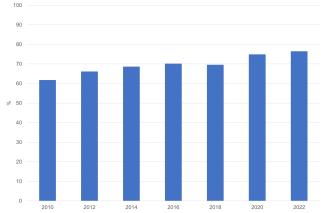Panel 1
Simona Buscemi, Cristina Frizza, Costanza Mariotta, Jessica Tuscano
The indicator is useful for monitoring progress toward a circular economy, allowing for the identification of the quantities of materials reintroduced into the economy following waste treatment. Compared to the total amount of waste sent for recovery and disposal operations, more than three-quarters of the treated waste is recycled, placing Italy among the countries with the highest recycling rates.
The waste recycling rate monitors the amount of material reintroduced into the economy. This indicator measures the ratio of recycled waste to the total amount of treated waste, excluding major mineral waste from the construction and demolition sector. The exclusion is due to the significant impact of this type of waste on total management, and normalizing the ratio enables a more meaningful comparison, even between countries with significant mining and construction sectors.
To monitor progress toward a circular economy in the thematic area of "waste management."
Directive 2008/98/EC, Legislative Decree No. 152/2006 and subsequent amendments
Regulation 2150/2002/EC on waste statistics
National Circular Economy Strategy approved by Ministerial Decree No. 259, June 24, 2022
The Directive 2008/98/EC establishes measures to protect the environment and human health by preventing or reducing waste production, minimizing the negative impacts of waste production and management, reducing the overall impacts of resource use, and improving their effectiveness and efficiency, which are fundamental for the transition to a circular economy and for ensuring the long-term competitiveness of the European Union.
Panel 2
ISPRA - Rapporto rifiuti urbani - Edition 2025
ISPRA - Rapporto rifiuti speciali - Edition 2024
Data quality assessment
EUROSTAT (Statistical Office of the European Communities)
ISPRA (Higher Institute for Environmental Protection and Research)
Sono utilizzate le informazioni contenute nella banca dati delle dichiarazioni ambientali annuali (MUD) effettuate dai soggetti obbligati ai sensi della legislazione vigente, non accessibili al pubblico. I dati di gestione di rifiuti urbani e speciali, pericolosi e non, sono consultabili sul sito web del Catasto Rifiuti, all’indirizzo www.catasto-rifiuti.isprambiente.it.
National
2010-2022
Indicator assessment
The indicator is obtained from the ratio between the amount of recycled waste and the total amount of treated waste. It includes both hazardous and non-hazardous waste from all economic sectors and households, including those from waste treatment. Major mineral waste, as defined by Regulation 2150/2002/EC on waste statistics, is excluded, including:
• Construction and demolition mineral waste (cement, bricks, gypsum, road surfacing materials containing hydrocarbons, mixed construction waste)
• Other mineral waste (asbestos, natural mineral waste, artificial mineral residues, refractory material residues)
• Earth
• Dredged earth
It should be noted that the waste statistics used to calculate the indicator, reported to the European Commission under Regulation 2150/2002/EC, do not include the quantities of waste sent to certain recovery and/or disposal operations. The quantity of recycled waste is calculated as the amount of waste recycled in national facilities plus the amount of waste sent for recycling abroad, excluding imported waste recycled in national facilities. Energy recovery or backfilling operations are excluded.
In 2022, more than three-quarters of the waste sent for treatment (76,5%) underwent recycling operations. In 2020, at the European level, Italy ranked among the countries with the highest recycling rate, after Belgium, Slovenia, and the Netherlands.
The percentage of recycled waste relative to the total waste sent for recovery/disposal operations shows an increasing trend from 2010 to 2022, rising from 61,8% in 2010 to 76,5% in 2022, except for 2018, when the recycling rate dropped by 0,6 percentage points compared to 2016. It is noteworthy that, in 2020, despite the significant impact of the COVID-19 health emergency on national consumption and waste production, the national management system ensured the interception of waste flows and their treatment.
Data
Table 1: Management of total waste excluding major mineral wastes and quantity of waste recycled with corresponding recycling rate
ISPRA elaborations based on ISPRA and Eurostat data


The trend of the recycling rate has generally been increasing over the years. In 2022, it rose by 1,6 percentage points compared to 2020 and by 6,9 percentage points compared to 2018 (Table 1 and Figure 1). The Italian industry has long been committed to the virtuous management of waste, progressively reducing its reliance on foreign raw materials, of which Italy is notably deficient, for industrial processes.